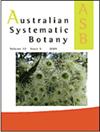Plastid phylogenomics of the Eriostemon group (Rutaceae; Zanthoxyloideae): support for major clades and investigation of a backbone polytomy
IF 1.6
3区 生物学
Q4 EVOLUTIONARY BIOLOGY
引用次数: 0
Abstract
ABSTRACT Most of Australia’s sclerophyllous Rutaceae belong to a clade informally known as the ‘Eriostemon group’ (including 16 genera, ~209 species). We investigated generic relationships in this group using analyses of complete plastome sequence data for 60 species and analyses of a supermatrix including sequences of four plastome spacer regions for 22 additional species. Maximum likelihood, Bayesian inference, and shortcut coalescent phylogenetic analyses produced congruent phylogenies that were highly supported, except for a series of short unsupported branches in the backbone of the Eriostemon group. We found high support for four major clades branching from this polytomy and discuss evolutionary inferences of generic relationships in each lineage. In an effort to resolve the polytomy, we analysed gene tree topologies in tree space, phylogenetic informativeness with likelihood mapping, and conducted topology tests to assess support for all possible topological resolutions of the polytomy. These approaches did not clarify the polytomy, which may be caused by insufficient data, features of plastome evolution, or rapid radiation. Results from analyses of the combined supermatrix dataset suggest that Philotheca section Philotheca is paraphyletic with regards to Drummondita and Geleznowia. In all phylogenies, Philotheca sections Corynonema and Cyanochlamys were not placed with other members of Philotheca.Eriostemon群的质体系统发育学(芸香科;番荔枝科):对主要分支的支持和对主干多体的研究
摘要澳大利亚硬叶芸香科的大部分属于一个被非正式地称为“Eriostemon群”的分支(包括16属,~209种)。我们使用对60个物种的完整质体序列数据的分析和对包括另外22个物种的四个质体间隔区序列的超矩阵的分析,研究了这一组中的一般关系。最大似然、贝叶斯推断和快捷联合系统发育分析产生了一致的系统发育,这些系统发育得到了高度支持,除了棘背龙群主干中的一系列短的无支持分支。我们发现四个主要分支的高度支持从这个多元体分支,并讨论了每个谱系中一般关系的进化推断。为了解决多体性,我们分析了树空间中的基因树拓扑结构、具有似然映射的系统发育信息性,并进行了拓扑测试,以评估对多体性所有可能拓扑解决方案的支持。这些方法没有阐明多体性,这可能是由数据不足、质体进化特征或快速辐射引起的。对组合超矩阵数据集的分析结果表明,关于Drummondita和Geleznowia,Philotheca部分是异基因的。在所有的系统发育中,Philotheca的Corynonema和Cyanochlamys部分没有与Philothea的其他成员放在一起。
本文章由计算机程序翻译,如有差异,请以英文原文为准。
求助全文
约1分钟内获得全文
求助全文
来源期刊

Australian Systematic Botany
生物-进化生物学
CiteScore
3.10
自引率
12.50%
发文量
12
审稿时长
>12 weeks
期刊介绍:
Australian Systematic Botany is an international journal devoted to the systematics, taxonomy, and related aspects of biogeography and evolution of all algae, fungi and plants, including fossils. Descriptive taxonomic papers should normally constitute a comprehensive treatment of a group. Short papers on individual species and nomenclatural papers must contain significant new information of broader interest to be considered. The prestigious L.A.S. Johnson Review Series is published. Other review articles will also be considered. All papers are peer reviewed.
Australian Systematic Botany is published with the endorsement of the Commonwealth Scientific and Industrial Research Organisation (CSIRO) and the Australian Academy of Science.
 求助内容:
求助内容: 应助结果提醒方式:
应助结果提醒方式:


